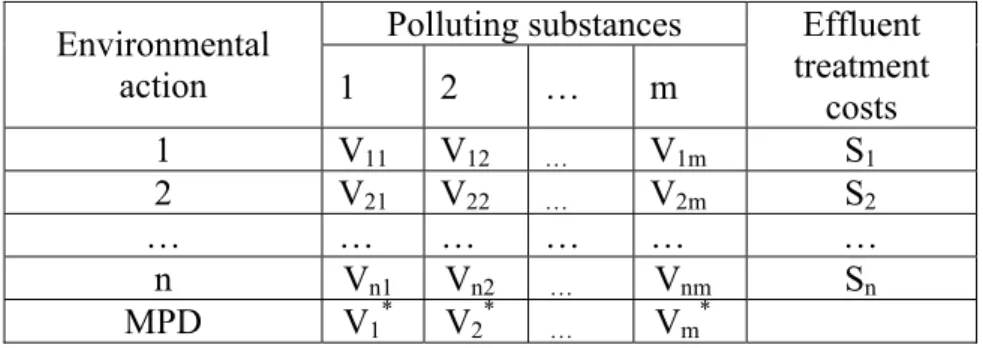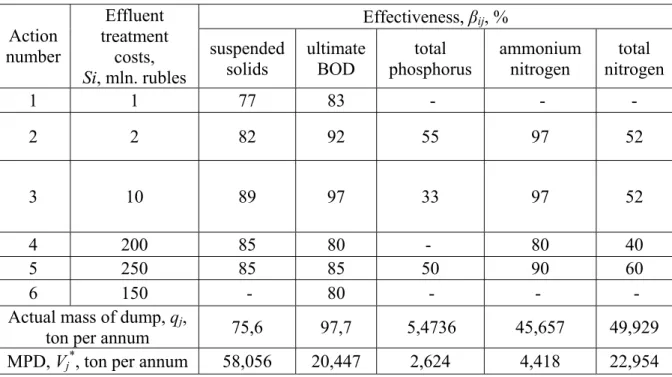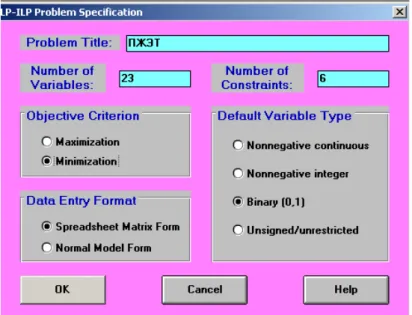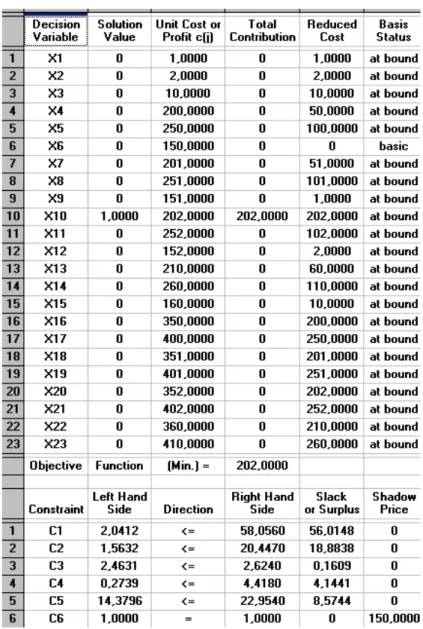ECOLOGICAL-ECONOMIC MODELLING
TO MAINTAIN MAXIMUM ALLOWABLE
DISCHARGE OF SUBSTANSES
INTO THE WATER BODY
Anna Severina
A.I. Shishkin
St.-Petersburg State Polytechnic University, Russia
ABSTRACT
Today administrative mechanisms of ecological management are primary in Russia. Their inefficiency is defined by absence of advancing influence and the due control. These mechanisms, as a rule, start to operate when negative influence is already made and harm to the environment is done. The work urgency is caused by the sharpness of the water legislation and regulation problems in Russia, as this sphere is the crossroads of all industrial, agricultural interests and also providing good life conditions for the population. The urgency of ecological-economic modelling is caused by rapid development of ecological management systems in the last years. That is stimulated by the aspiration of market participants to raise management efficiency of the enterprises, to lower power and resources consumption, to raise the quality of goods and services, to create more comfortable working conditions, to provide safety of the personnel and, as a result, to improve the reputation and to raise their competitive advantages.
The purpose of the work is to draw up and to deicide a problem of ecological-economic optimization within the limits of linear programming for a “water user – water body” system. Such a linear programming problem is similar to the model of investment projects choice. The problem’s solution is based on searching the best, from the economic point of view, sewage treat system to maintain maximum allowable discharge of substances into the water body.
KEYWORDS
Ecological-economic modeling; Maximum allowable discharge; Sewage treat system; Linear programming problem.
1 INTRODUCTION
The basic scopes of ecological-economic modeling, as the basic research method of economy of environmental economics, are:
- working out of the indicators characterizing quality of environment,
- forecasting of possible environmental changes as a result of acceptance of various (mainly, economic) decisions,
- environmental management planning (for example, waste treatment plants construction, creation of non-waste technologies).
Such problems of ecological-economic optimization as the water charge optimization [1], the assessment of environmental measures for water bodies protection taking into account economic and ecological requirements [2] and others can be solved by means of ecological-mathematical modeling methods.
The major principle of ecological-economic modeling is the minimax principle: in all cases the use of natural resources, improvement of one or other environmental objects (for example, water or air pollution elimination) should bring the maximum social utility at the minimum corresponding activity costs. Particularly, the comparison of environment improvement costs or pollutants elimination costs with the received ecological benefit can act as an optimality criterion.
Various measures can be used when working out the water protection program. These measures possess different indicators of ecological efficiency and various costs for their realization, all that requires an ecological-economic optimization problem statement. Mathematically an optimization problem statement for a “water user – water body” system means the following: it is required to choose such a complex of the water protection measures providing set effluent standards of harmful substances, at which the sum of water-protective measures realization costs (building or reconstruction of a water protection structure) tends to a minimum.
2 ADAPTATION OF AN INVESTMENT PROJECTS OPTIMUM CHOICE PROBLEM TO THE ECOLOGICAL-ECONOMIC MODELING CONDITIONS
It has been noticed by the author that the ecological-economic optimization problem to maintain maximum allowable discharge of substances into a water body can be presented in the form of a mathematical model similar to the model about the choice of investment projects within the limits of linear programming [3]. An investment projects optimum choice problem adaptation to the specified conditions taking into account the input of restrictive criteria in the form of effluent standards (maximum allowable discharge) is presented by table 1 and system (1) located lower.
Table 1.Linear programming problem parameters.
Polluting substances Environmental action 1 2 … m Effluent treatment costs 1 V11 V12 … V1m S1 2 V21 V22 … V2m S2 … … … n Vn1 Vn2 … Vnm Sn MPD V1* V2* … Vm*
{ }
⎪ ⎪ ⎪ ⎪ ⎪ ⎪ ⎩ ⎪ ⎪ ⎪ ⎪ ⎪ ⎪ ⎨ ⎧ = = ∈ = ≤ ⋅ → ⋅ =∑
∑
∑
= ∗ = = m j n i x x V x V x S S i n i i j n i i ij n i i i , 1 , 1 1 , 0 ; 1 ; min; 1 1 1 (1)Variables Xi represent various actions (effluent treatment systems, and also their
combinations) which can be applied at an enterprise for the industrial waste waters treatment
to maintain maximum permissible discharge (MPD) of substances. Xi are binary variables
which can accept only two values (1 and 0) depending on, whether the effluent standards are provided at the choice of the i-th action (Xi=1) or not (Xi=0).
S – the objective function minimizing effluent treatment costs (Si), its coefficients are rated
according to the formula:
Si =Σαij qj βij,
where αij – the cleaning up cost of a mass unit of the j-th substance within the limits of the
i-th action – is got for each technology of effluent treatment by taking account of capital and operating costs; qj – the mass of polluting substances dumped into the water body – actual
discharge for each polluting substance; βij - a part of discharged mass which is cleaned up –
the effectiveness index of the j-th substance treatment within the limits of the i-th action. Coefficients at variables from inequalities-constraints which represent the dumped mass of the j-th substance after the realization of the i-th action, are rated according to the formula:
Vij = qj (1 – βij).
Constants in the left parts of inequalities (Vj*) – maximum permissible discharge (MPD) of
the j-th polluting substance.
The result of solving an optimization problem within the limits of linear programming is the choice of the one optimal action for waste water’s cleaning up that is provided with the introduction of the following equation into the systems of constraints:
1 1 =
∑
= n i i x . Such an action for waste water’s cleaning up, in comparison with others considered, will have the least cost at the maintenance of all polluting substances’ effluent standards expressed in inequalities-constraints. The problem will have the solution in case at least one of actions satisfies all inequalities-restrictions of system (1).2 THE SEARCH OF AN OPTIMUM VARIANT OF SEWAGE TREAT SYSTEM FOR MAINTENANCE OF MAXIMUM PERMISSIBLE DISCHARGE NORMS ON THE
MUE "ПЖЭТ" – the municipal unitary enterprise which is situated in the town of Communar in the St.-Petersburg region and dumps its waste waters into the Izhora river which is the left tributary of the Neva river. There is the excess of permissible discharge in following substances of its waste waters: suspended solids - 30%, ultimate BOD – 378%, total phosphorus - 108%, ammonium nitrogen - 933%, total nitrogen - 117%.
The following actions can be carried out to decrease the discharged mass of these polluting substances at the enterprise: 1 – replacement of the aeration system; 2 – realization of 5-zonal aeration system with the replacement of the existing aeration system to fine-bubble; 3 - replacement of the aeration system, realization nitrate and anoxic recirculation of mixed liquor, installation of mechanical mixing devices; 4 - afterpurification at sand filters; 5 - afterpurification at biofilters; 6 - disinfection by chlorine. Effectiveness of the given actions, and also actual and standard characteristics of the enterprise’s waste waters about five mentioned above polluting substances are presented in table 2.
Table 2.Effluent treatment effectiveness, actual mass of dump and maximum permissible discharge of MUE "ПЖЭТ". Effectiveness, βij, % Action number Effluent treatment costs, Si, mln. rubles suspended
solids ultimate BOD phosphorus total ammonium nitrogen nitrogentotal
1 1 77 83 - - - 2 2 82 92 55 97 52 3 10 89 97 33 97 52 4 200 85 80 - 80 40 5 250 85 85 50 90 60 6 150 - 80 - - -
Actual mass of dump, qj,
ton per annum 75,6 97,7 5,4736 45,657 49,929
MPD, Vj*, ton per annum 58,056 20,447 2,624 4,418 22,954
Twenty three possible combinations of 6 variants mentioned before actions for sewage treatment were analyzed to make the statement of a linear programming problem for the optimum choice of the clearing up action to maintain the norms of maximum permissible discharge. These combinations are represented by variables Xi from the system of equations
and inequalities (1). The dumped masses (Vij, ton per annum) of 5 mentioned above polluting
substances after waste waters’ cleaning up using each of 23 possible variants and also the their costs are presented in table 3.
Thus in tables 2 and 3 there are values of all parameters from system (1) that makes it possible to solve a linear programming problem and to choose one optimum variant from 23
combinations of sewage treatment methods which has the least cost and provides the achievement of maximum permissible discharge norms.
Table 3
The dumped masses of polluting substances after the realization of cleaning up actions. Vij, ton per annum
Variables Xi Action number Si, mln.
rubles suspended solids ultimate BOD phosphorustotal ammonium nitrogen nitrogen total
X1 1 1 17,388 16,609 5,474 45,657 49,929 X2 2 2 13,608 7,816 2,463 1,370 23,966 X3 3 10 8,316 2,931 3,667 1,370 23,966 X4 4 200 11,340 19,540 5,474 9,131 29,957 X5 5 250 11,340 14,655 2,737 4,566 19,972 X6 6 150 75,600 19,540 5,474 45,657 49,929 X7 1+4 201 2,608 3,322 5,474 9,131 29,957 X8 1+5 251 2,608 2,491 2,737 4,566 19,972 X9 1+6 151 17,388 3,322 5,474 45,657 49,929 X10 2+4 202 2,041 1,563 2,463 0,274 14,380 X11 2+5 252 2,041 1,172 1,232 1,233 9,586 X12 2+6 152 13,608 1,563 2,463 1,370 23,966 X13 3+4 210 1,247 0,586 3,667 0,274 14,380 X14 3+5 260 1,247 0,440 1,834 0,137 9,586 X15 3+6 160 8,316 0,586 3,667 1,370 23,966 X16 4+6 350 11,340 3,908 5,474 9,131 29,957 X17 5+6 400 11,340 2,931 2,737 4,566 19,972 X18 1+4+6 351 2,608 0,664 5,474 9,131 29,957 X19 1+5+6 401 2,608 0,498 2,737 4,566 19,972 X20 2+4+6 352 2,041 0,313 2,463 0,274 14,380 X21 2+5+6 402 2,041 0,234 1,232 0,137 9,586 X22 3+4+6 360 1,247 0,117 3,667 0,274 14,380 X23 3+5+6 410 1,247 0,088 1,834 0,137 9,586
3 SOLVING THE LINEAR PROGRAMMING PROBLEM USING WINQSB PROGRAM
Such a linear programming problem can be solved using WINQSB program. Figure 1 shows the input parameters window of the problem with 23 binary variables, and 5 inequalities-constraints, a single equation, as well as the objective function aimed at a minimum.
The option “Solve the Problem” is selected after entering all the parameters of the problem in matrix form. Here the problem is solved by branch and bound method, if at least one of
the objective function is not limited (the problem is unbounded) [4]. The results of solving the problem are reflected in the summary report, shown by figure 2.
Figure 2. Summary report on solving the linear programming problem.
4 RESULTS
From the summary report of solving ecological-economic optimization problem in linear programming to choose an optimal sewage treat system (figure 2) we can conclude the
following: the variant number 10 (X10=1) is considered to be the optimal action for the
enterprise MUE “ПЖЭТ” sewage treatment.
Under the variable X10 was encrypted the combination of cleaning up methods (2+4): 2 –
realization of 5-zonal aeration system with the replacement of the existing aeration system to fine-bubble, 4 - afterpurification at sand filters. The cost of this action will be 202 million rubles (4926829 €).
achieve the specified quality parameters of effluent (maximum permissible discharge). In the case of a large selection of processing methods for sewage treatment the model allows to choose the best variant, taking into account two main criteria: the sufficient purification efficiency to achieve the effluent standards and the minimum cost of implementation.
REFERENCES
[1] Glukhov V.V., Nekrasova T.P. Economic foundations of ecology - 3rd ed.- St. Petersburg: Piter, 2003 - 383.
[2] Shishkin A.I., Severina A.V., Sophijskaya E.Y. Ecological-economic modeling in the system "user of water user-water body" / / Abstracts of scientific conference. Prediction and prevention problems of emergencies and their consequences. - St. Petersburg: University ETU "LETI", 2007 - 107-112.
[3] Yuriev V.N., Optimization methods in economics and management - St. Petersburg: Polytechnic Univ. Press, 2006 - 37-38.
[4] Kutuzov A.L., Mathematical methods and models of operations research. Linear optimization with WinQSB and Excel - St. Petersburg: Polytechnic Univ., 2004. - 88.



